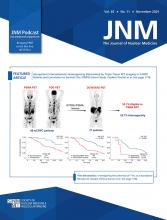The cost of “1 size fits all”: Stabin provides perspective as both a cancer survivor and nuclear medicine professional on the importance of patient-individualized approaches to radiopharmaceutical therapies.
Page 1661
Discussions with leaders: Michal Horný discusses his research on the changing contribution of medical imaging to total U.S. health care costs.
Page 1663
RPT patient care: Calais and colleagues outline guidance on best practices for delivering PSMA-targeted radiopharmaceutical therapy to patients with metastatic castration-resistant prostate cancer, emphasizing the importance of cross-disciplinary collaboration in management.
Page 1666
Analysis of prognostic indices: Chartier and colleagues offer an educational overview of methods for comparing prognostic indices in oncology and for demonstrating associated predictive impacts through clinical trials.
Page 1672
PET in nongranulomatous myocarditis: Pelletier-Galarneau and colleagues highlight the utility of 18F-FDG PET in identifying inflammation in this challenging indication, including patient selection for immune-modulatory therapy and optimal timing for mechanical intervention or resumption of activities.
Page 1679
Is CXCR4 PA imaging really happening? Li and colleagues explore whether the clinical application of C-X-C chemokine receptor type 4 imaging in primary aldosteronism is truly under way, including mechanisms, current status, and future prospects.
Page 1681
TRT in SST-positive tumors: Taïeb and colleagues combine observations from experience in targeted radionuclide therapy in somatostatin receptor–positive tumors, recent clinical trial data, and general radiation biology to identify potential changes to theranostics delivery and definition of efficacy endpoints.
Page 1685
18F-FES PET in breast cancer: Ryu and colleagues assess the impact of 18F-FES PET/CT on routine clinical management of patients with recurrent or metastatic breast cancer.
Page 1689
Granzyme B PET/CT in gastric cancer: Liu and colleagues report on development of a PET/CT probe targeting granzyme B and investigate its use in monitoring the effects of immune checkpoint inhibitors early in the course of therapy.
Page 1695
18F-FAPI PET/CT in esophageal cancer: Dong and colleagues research the ability of 18F-FAPI PET/CT to predict response to neoadjuvant camrelizumab plus chemotherapy in locally advanced esophageal squamous cell carcinoma.
Page 1702
Heterogeneity in mCRPC patients: Pouliot and colleagues use a triple-tracer PET imaging strategy to look at intrapatient intermetastatic heterogeneity and radiopharmaceutical therapy eligibility in metastatic castration-resistant prostate cancer.
Page 1710
Senescence and cancer imaging with uPAR: Pratt and colleagues describe development of 2 antibodies against murine and human urokinase plasminogen activator receptors as immuno-PET agents with promise in pancreatic cancer and chemotherapy-induced senescence.
Page 1718
[177Lu]Lu-PSMA-617 in the clinic: Gafita and colleagues detail the efficacy, safety, and outcome predictors observed in routine use of this FDA-approved therapy for metastatic castration-resistant prostate cancer.
Page 1724
Free-to-total PSA ratio and PET metastases: Bernardino and colleagues investigate the association of free-to-total prostate-specific antigen ratios and 18F-DCFPyL PSMA PET/CT positivity in patients with biochemical recurrence of prostate cancer.
Page 1731
VISION versus EAP clinical outcomes: Murthy and colleagues evaluate the efficacy and safety profile of [177Lu]Lu-PSMA-617 treatment in metastatic castration-resistant prostate cancer within the U.S. expanded access program and compare results with those from the VISION trial.
Page 1740
Cardiac metastases on 68Ga-DOTATATE PET: Lee and colleagues document the prevalence, clinical characteristics, imaging features, and outcomes in neuroendocrine tumor patients with cardiac metastases on 68Ga-DOTATATE PET/CT.
Page 1745
Indications for [64Cu]Cu-DOTATATE PET/CT: Carlsen and colleagues perform systematic analyses of referral patterns and image findings for routine 64Cu-DOTATATE PET/CT imaging in neuroendocrine neoplasms to support appropriate use criteria development.
Page 1754
226Ac theranostics: Koniar and colleagues report on a proof-of-concept preclinical study evaluating a 226Ac-radiopharmaceutical for theranostic efficacy.
Page 1762
212Pb-DOTAM-GRPR1 radiopharmaceutical: Saidi and colleagues assess the feasibility of this α-particle–labeled gastrin-releasing peptide receptor–targeting agent in a preclinical prostate cancer model.
1769
68Ga-FAPI46 PET in hypertension: Byun and colleagues evaluate FAP expression and fibrosis in a preclinical hypertension model and test the feasibility of 68Ga-FAPI46 PET imaging in hypertension.
Page 1776
SUVR with [11C]UCB-J in AD: Young and colleagues validate a simplified tissue-to-reference ratio method using SUV ratios for estimating synaptic density with [11C]UCB-J PET in Alzheimer disease assessment.
Page 1782
AUC for nuclear medicine in FUO: Palestro and members of a multisociety professional working group summarize recently published appropriate use criteria for nuclear medicine techniques in fever of unknown origin.
Page 1786
FAPI PET and pathology correlation in ILD: Hotta and colleagues use immunohistochemistry to document 68Ga-FAPI-46 uptake in explanted lungs of patients with advanced interstitial lung disease.
Page 1789
Registry for hybrid cardiac imaging: Miller and a team of international experts present the design and initial results from the updated Registry of Fast Myocardial Perfusion Imaging with Next-Generation SPECT.
Page 1795
AI prediction and DLBCL: Ferrández and colleagues apply a previously developed deep learning model for predicting progression in diffuse large B-cell lymphoma using data from 5 independent clinical trials and compare results with the international prognostic index standard.
Page 1802
MIRDfit dosimetry software: Carter and colleagues introduce a biodistribution fitting software solution for internal dose assessment that offers nuclear medicine–appropriate fit functions and multiple other quality control and integration advantages.
Page 1808
MUC5AC antibody PET in pancreatic cancer: Kulkarni and colleagues offer a case report of first-in-human PET imaging with 89Zr-hNd2, a mucin 5AC–targeting agent, in an individual with pancreatic-head adenocarcinoma and liver metastasis.
Page 1815
Freehand SPECT with LiDAR: Pisano and colleagues detail a hybrid freehand SPECT/LiDAR prostate cancer specimen imaging technique with the potential to provide a low-cost and low–radiation dose alternative to postoperative PET scanning.
Page 1816
- © 2024 by the Society of Nuclear Medicine and Molecular Imaging.







